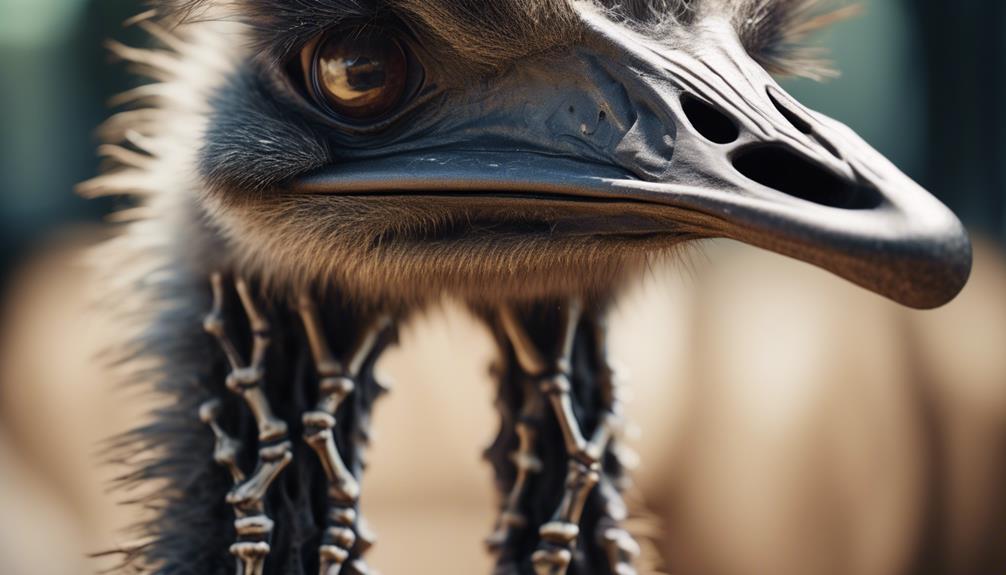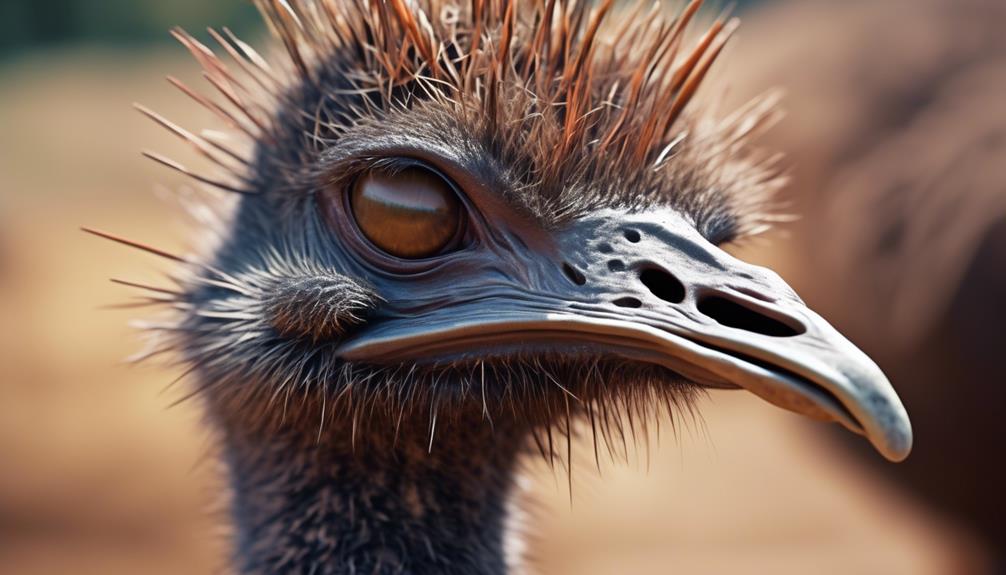
Step right up and prepare to embark on an enchanting journey into the remarkable world of the anatomy and physiology of emus.
These magnificent creatures, with their distinctive appearance and majestic presence, hold within them a treasure trove of intricate systems waiting to be unraveled.
From their skeletal structure to their reproductive system, each aspect of their being contains secrets waiting to be unveiled.
So, fasten your seatbelt and prepare to be amazed as we delve into the depths of the emu's inner workings, where wonder and discovery await at every turn.
Skeletal Structure

The skeletal structure of emus is characterized by a strong and flexible framework that enables them to support their large body size and adapt to their unique locomotion. Emus are flightless birds native to Australia, and their skeletal adaptations play a crucial role in their ability to move efficiently on land.
One notable adaptation is their highly modified limbs, which are designed to provide stability and strength while minimizing energy expenditure. Emus have long, slender limbs with strong bones that support their massive bodies. These bones are specialized to withstand the forces generated during locomotion, allowing the emus to run at high speeds without risking fractures or injuries.
The bones of their legs, particularly the femur and tibia, are elongated and fused together to form a strong lever system. This configuration increases the mechanical advantage of their muscles, allowing for powerful propulsion with every stride.
Additionally, emus possess a unique hip structure that contributes to their efficient locomotion. Their hip bones are broad and fused, providing a stable platform for their powerful leg muscles to generate force. This design prevents excessive movement at the hip joint, ensuring that the energy produced by the muscles is efficiently transmitted to the legs, resulting in efficient and swift movements.
Muscular System
With their specialized skeletal structure in place, emus now rely on their muscular system to power their efficient locomotion. The emu's muscle anatomy is a marvel of adaptation, allowing them to run at incredible speeds and navigate various terrains with ease.
- Powerful Legs: Emus possess strong leg muscles, particularly in their thighs and calves. These muscles generate the force required for propulsion during running. The gastrocnemius and quadriceps femoris muscles are especially well-developed, allowing for explosive bursts of speed.
- Wings for Balance: Despite being flightless, emus still have wings that serve a crucial purpose. The muscles in their wings help with balance and stability while running. These muscles, such as the deltoids and pectoralis major, work in synergy with the legs to maintain the emu's body position and prevent falls.
- Flexible Neck and Head: Emus have remarkable control over their long necks and heads. The neck muscles, including the splenius capitis and the sternocleidomastoid, enable them to make quick movements and scan their surroundings. This flexibility aids in predator detection and allows emus to react swiftly to potential threats.
The intricate coordination and strength of the emu's muscular system are essential for their impressive locomotion. Whether sprinting across open fields or navigating dense vegetation, the emu's well-developed muscles enable them to thrive in their natural habitat.
Cardiovascular System

An emu's cardiovascular system facilitates the efficient delivery of oxygen and nutrients throughout its body, enabling it to sustain its incredible speed and endurance. The emu's heart rate is a key factor in its cardiovascular system.
At rest, an emu's heart beats at a relatively low rate of around 40-60 beats per minute. However, during periods of intense physical activity, such as running or mating rituals, the heart rate can increase significantly, reaching up to 200 beats per minute. This increased heart rate allows for a higher volume of blood to be pumped to the muscles, supplying them with the necessary oxygen and nutrients to sustain the emu's impressive performance.
Emu blood circulation is highly efficient, thanks to their unique circulatory system. Like other birds, emus have a four-chambered heart, which separates oxygenated and deoxygenated blood. This ensures that the oxygen-rich blood from the lungs is efficiently pumped to the rest of the body, while the deoxygenated blood is sent back to the lungs to be reoxygenated.
The emu's blood vessels are also well-adapted to their needs. Their arteries are strong and elastic, allowing for efficient blood flow, while their veins have valves that prevent the backflow of blood, ensuring a one-way circulation system.
Respiratory System
To understand the remarkable speed and endurance of emus, it's essential to explore the intricate workings of their respiratory system. Emus possess a unique breathing mechanism that allows them to efficiently extract oxygen from the air, enabling them to sustain their high levels of activity.
The respiratory adaptations of emus are truly fascinating. Here are three key features of their respiratory system:
- Highly efficient lungs: Emus have well-developed lungs with a large surface area for gas exchange. The walls of their lungs are thin, allowing for rapid diffusion of oxygen into the bloodstream. This efficient exchange of gases ensures an ample supply of oxygen to their muscles during strenuous activities.
- Air sac system: Emus possess a complex system of air sacs that extend throughout their body. These air sacs act as reservoirs, allowing for a continuous flow of fresh air during both inhalation and exhalation. This system enhances the efficiency of gas exchange by ensuring a constant supply of oxygen and the removal of carbon dioxide.
- Efficient oxygen transport: Emus have a high concentration of red blood cells, enabling them to effectively transport oxygen to their muscles. Additionally, their blood contains a special oxygen-binding protein called hemoglobin, which enhances oxygen-carrying capacity.
Emus' breathing mechanism and respiratory adaptations contribute to their exceptional endurance and speed. By efficiently extracting oxygen from the air and transporting it to their muscles, emus can sustain their impressive physical prowess for extended periods.
Digestive System

The digestive system of emus efficiently breaks down and absorbs nutrients to support their high-energy lifestyles. Emus have a unique diet consisting of vegetation, insects, small animals, and even stones. Their digestion process begins in the beak, where emus use their sharp beaks to break down food into smaller pieces. The food then moves to the esophagus, where it is transported to the crop, a specialized pouch that stores and softens the food. From the crop, the food enters the proventriculus, which secretes digestive enzymes to further break down the food.
Next, the food enters the gizzard, a muscular organ that contains small stones. The powerful contractions of the gizzard help grind the food and the stones together, aiding in the mechanical breakdown of tough plant material. This unique adaptation allows emus to effectively digest fibrous vegetation. The partially digested food then proceeds to the small intestine, where the majority of nutrient absorption occurs. Finally, the remaining waste material passes into the large intestine and is excreted as feces.
Here is a table summarizing the emus' digestion process:
| Digestive Organ | Function |
|---|---|
| Beak | Breaks down food into smaller pieces |
| Crop | Stores and softens the food |
| Proventriculus | Secretes digestive enzymes |
| Gizzard | Grinds food with stones for mechanical breakdown |
| Small Intestine | Absorbs nutrients from the food |
| Large Intestine | Excretes waste material as feces |
Emus' digestive system is highly adapted to their unique diet, allowing them to efficiently obtain the necessary nutrients for their active and energetic lifestyles.
Reproductive System
After efficiently breaking down and absorbing nutrients from their unique diet, emus' highly adapted digestive system now transitions to the discussion of their reproductive system. As fascinating creatures, emus have a complex reproductive process that involves various behaviors and physiological adaptations.
The reproductive system of emus is primarily focused on egg production. Females are responsible for producing and laying the eggs, which are a vital part of their species' continuation. Emus typically start laying eggs when they reach the age of two, and they can lay up to 50 eggs throughout the breeding season.
Mating behavior plays a crucial role in the reproductive process of emus. During the breeding season, males establish territories and perform elaborate courtship displays to attract females. These displays often involve puffing up their feathers, emitting deep booming calls, and performing unique movements. Once a male successfully attracts a female, they'll engage in mating rituals that involve the male mounting the female and transferring sperm.
Frequently Asked Questions
How Do Emus Communicate With Each Other?
Emus communicate with each other through a combination of vocalizations and body language. Their vocalizations include deep booming sounds, drumming, and grunts, while their body language involves head movements, wing displays, and posturing.
What Is the Lifespan of an Emu?
You might be curious about how long those magnificent emus live. Well, let me tell you, their lifespan can vary depending on various factors like genetics, diet, and habitat conditions. Fascinating stuff!
Do Emus Migrate to Different Regions?
Emus, as fascinating creatures, do migrate to different regions, impacting both the ecosystem and their role as a food source. Understanding their migratory patterns sheds light on their adaptability and survival strategies.
How Do Emus Defend Themselves Against Predators?
Emus defend themselves against predators using a combination of physical attributes and behavioral strategies. Their long, powerful legs allow them to kick with great force, while their large size and sharp beaks act as deterrents. They also use their keen eyesight to detect and avoid potential threats.
Are Emus Endangered or at Risk of Extinction?
Emus in captivity face challenges, but their population is stable. Emu conservation efforts focus on preserving their habitat and addressing threats. With proper management, emus are not currently endangered or at risk of extinction.
Conclusion
In conclusion, exploring the anatomy and physiology of emus provides fascinating insights into their remarkable adaptation and survival in their natural habitat.
While some may argue that studying such specific details may seem trivial, understanding the intricate skeletal structure, muscular system, cardiovascular system, respiratory system, digestive system, and reproductive system of emus allows us to gain a deeper appreciation for the complexity and resilience of these unique creatures.
By delving into these scientific intricacies, we unlock a greater understanding of the natural world and our own place within it.




